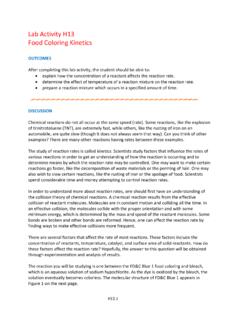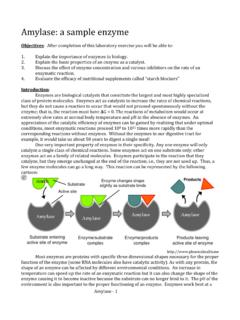Transcription of Enzyme Kinetics: Properties of â-Galactosidase
1 49 Enzyme Kinetics: Properties of -Galactosidase Preparation for Laboratory: Read the introduction to this laboratory before doing the Web Tutorial -Beta Galactosidase. Additional background: Freeman, skim pp 43-58 for a review of protein INTRODUCTIONE nzymes: Read Freeman - Enzyme action 55-65 before reactions are at the heart of all biological processes. The body must regulateprecisely all the chemical reactions going on in order to maintain life. Much of this regulation isdone by changing the activity of enzymes, which are biological catalysts. For the next two weeks we will be looking at the characteristics of a biological catalyst, or are usually proteins, although some RNAs are now known also to act as catalysts inbiological reactions .
2 You will investigate the functional Properties of the Enzyme -galactosidase,determine the reaction rate, and design and conduct and experiment on the potential interactionbetween pH and temperature on the sensitivity of this Enzyme . You will be using -galactosidaseisolated from the gut bacteria Escherichia coli. E. coli lives in the gut where the temperature isapproximately 37 C and the pH is Do you think the Enzyme will have the same efficiencyoover a range of temperatures and pHs?The Reaction:What is the function of -galactosidase? -galactosidase catalyzes the breakdown of thesubstrate lactose, a disaccharide sugar found in milk into two monosaccharide sugars, galactose andglucose.
3 The oxygen bridge connecting the two sides of the lactose molecule is cleaved through theaddition of a water molecule. The addition of the water molecule is known as Assay:Since it is difficult to assay for the activity of -galactosidase when lactose is the substrate,we will use the lactose analog ONPG (o-nitrophenyl -D-galactopyranoside) in our the similarity in the structure of ONPG and lactose. The Enzyme does not distinguish betweenlactose and ONPG, and cleaves the oxygen bridge between the two sides of the molecule, resultingin the products galactose and the o-nitrophenol.
4 Note how this is similar to the production ofgalactose and glucolse when lactose is advantage of using ONPG as the substrate is that it is relatively easy to determine theamount of ONPG cleaved by using a spectrometric assay. ONPG is colorless, but the product ONP(o-nitrophenol) is yellow, so that as the -galactosidase continues to work, more and more ONPGis degraded, and the solution turns more and more yellow. By measuring the rate at which the colorintensity increases we can calculate the activity of the Enzyme . Optical density (OD) is a measureof the amount of light absorbed by a solution.
5 O-nitrophenol, the yellow product of the breakdownof ONPG, absorbs light maximally at 420nm. Thus OD 420 in this experiment is a measure of theamount of O-nitrophenol present in the sample and can be used to calculate -galactosidase more yellow the solution, the more ONPG has been degraded, and higher the absorbance. In23your assays today, you will be using NaCO to stop the Enzyme by making the solution too basicfor the Enzyme to function. (Why might the pH of the solution affect Enzyme activity?) Questions: If you added -galactosidase to a solution of pure ONPG, which direction would the reaction run?
6 Would it catalyze the hydrolysis of ONPG at a constant rate or would the reaction rate change overtime? How would the of the solution change over time? Write your hypotheses and sketcha simple plot of vs. time to show what you think will happen. Briefly justify your tutorial will provide background that will allow the class to design an experiment to investigatethe effect of pH and temperature on the activity of -galactosidase, using spectroscopy. The powerof the techniques that you will use will become obvious when you calculate how many reactions asingle molecule of -galactosidase catalyzes in a minute.
7 As part of the tutorial you will create a standard curve that describes the relationship betweenabsorbance and the concentration of ONP. Record the equations for the relationship below. Standard Curve Regression Equation: Conc = _____ + _____ * absorbanceData from 2008 is provided in the tutorial so you can also graph the relationship between time andthe activity of -galactosidase at room temperature as measured by the concentration of ONP in thereacting mixture. Enzyme activity : Conc (ONP) = _____ + _____ * timeMake sure you understand the relationships shown by both graphs.
8 Come to class prepared to designand conduct and experiment on the potential interaction of pH and temperature on the activity of proceed to the tutorial. II. Experimental Design:When designing experiments to explore the potential interaction between two variables itis important to make sure that a complete design is used. This means that all combinations of thetwo variables of interest are paired. For this experiment we will use two variables temperatureand pH in a 2x2, 2x3, 3x3 or 2x4 design. You have the following choice of pHs: 6, 7, , 8 )and temperatures (0, ~21, 37, 55C).
9 As a class you will discuss the design and fill in the o o oo table below to make sure the design is complete. Table 1. Experimental design to determine if pH and temperature have an interactive effect on -galactosidase 52 Setting up the reactions :Each table will be given a tube of -galactosidase solution with a concentration of ( units activity/ml). You will work in pairs. Room temperature _____ Duration of reaction:_____ Label the number of test tubes required for your experiment with the pH and temperature Add the appropriate buffer and mM ONPG Equilibrate to the selected temperature for _____ minutes Start the reaction by adding -galactosidase and record the time each test tube is started23 Keep a record of when each reacting mixture should be stopped by adding NaCO Stop the reaction Read the absorbance at 420nm using the appropriate pH blankStart with an 8:1:1 ratio of buffer:ONPG: Enzyme .
10 You will want the final volume of themixture to be 2ml (2000 l). Do your calculations in microliters ( l) and put them in Table 1. Standard quantities of reagents for preparing testtubes todetermine -galactosidase EnzymeTotal Volume l l l l23A 1:1 ratio of NaCO : reacting Enzyme mixture is used to stop the reaction. 23 Amount of NACO needed to stop each reaction _____ l or _____mlA blank is used to calibrate the spectrophotometer for 420nm readings.











